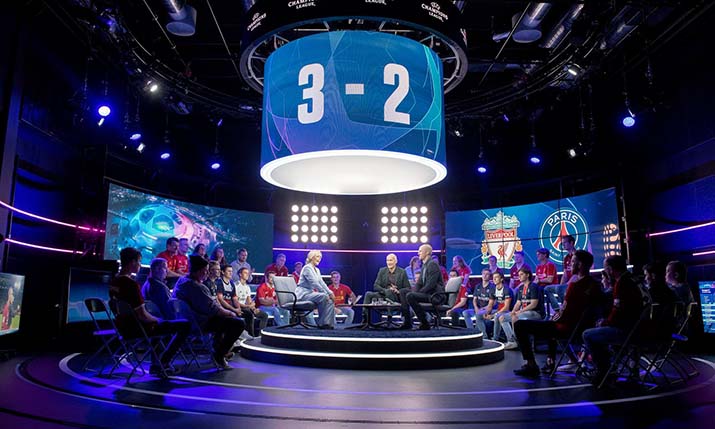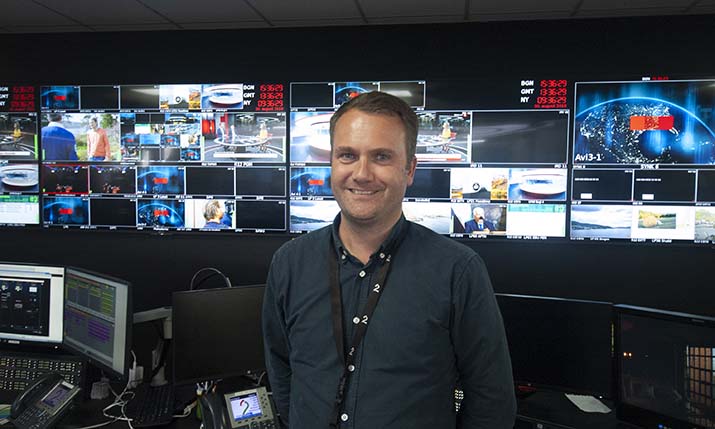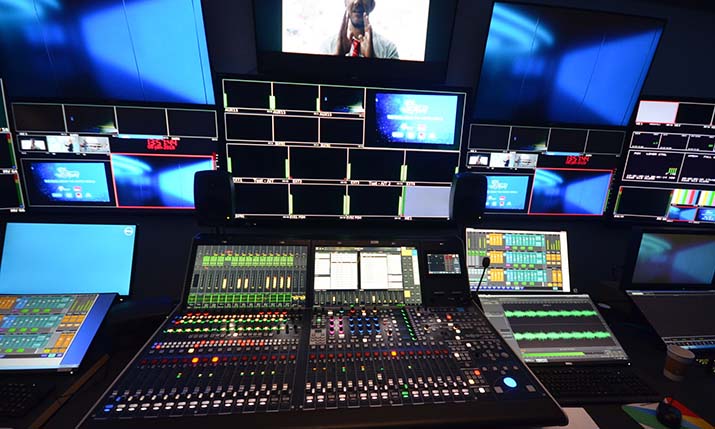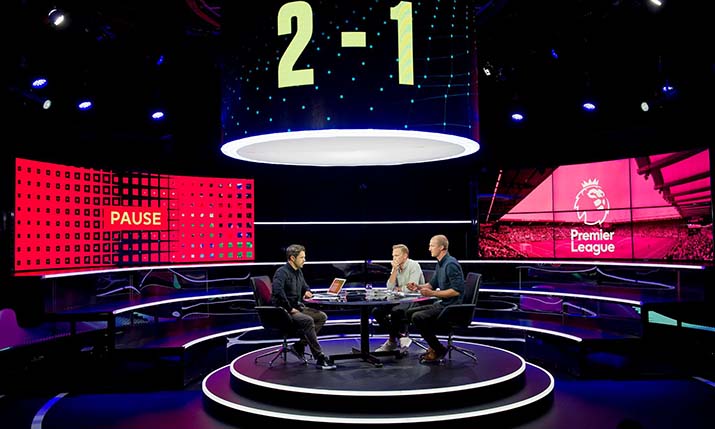Ring of change: TV2’s Svein Henning Skaga on the growth of audio and a career in sound

Studio A at TV 2. Football is a mainstay of the broadcaster’s primary and OTT output and is driving future moves to object-based sound
Solutions architect for live production at Norwegian broadcaster TV 2, Svein Henning Skaga, started out in audio at his local radio station as a DJ. However, he quickly found more affinity with the technical side of broadcast than with his initial role, spinning the decks.
He chose to train as an audio and broadcast engineer and spent a large and formative part of his early career in radio.
“I spent 15 years at P4 radio, part of the Nordic Entertainment Group (NENT) here in Norway,” Skaga says. “At that time, P4 covered sports quite extensively, so I spent much of my time working as a technician and producer at sports events all over the world – Olympics, skiing championships, handball and football championships – and lots more.”
At the time, Skaga was based in Oslo, but he and his wife were looking for a route home to Bergen, which led him to TV 2: “A position came up as a technical operations manager, which I thought would be a good opportunity to learn some new skills. For the first few years in TV 2 I didn’t work much with audio at all; I just tried to learn as much as I could about video and synchronisation, and all the other stuff you don’t get exposed to in radio.”

Svein Henning Skaga, solutions architect for live production at TV 2
Breaking into TV
Eventually Skaga’s experience in sports audio broadcasting was to prove invaluable: “TV 2 had broadcast rights for the Olympics in Sochi and in Rio,” he recalls. “Based on my sports experience in radio I was sent there as part of the operations teams. The biggest job there was actually mixing the mix-minus. Although we used a lot of remote production, we didn’t want presenter audio going to Norway and back again, so I took care of the local in-ear mixes. There was a lot to do, with presenters at several different arenas.”
Skaga notes that the role described would probably not be a local one now, as with progress in virtualisation the console would most likely be traveling to the event alone.
“With UHD there is an expectation of a better audio experience too, but it’s quite a demanding thing to have enough skilled operators to handle all this stuff, especially as it’s still relatively immature”
Skaga’s audio roots have come into play plenty of times since then, including when specifying infrastructure and tools for TV 2’s biggest recent shift – a move to new buildings and a new IP-based infrastructure.
The move happened in 2017, at TV 2’s Bergen and Oslo sites. “We decided to go entirely IP,” says Skaga. “Video over IP especially was still a bit immature at that time, particularly in standardisation, but audio was ready. We had the AES67 standard established, so we decided to build a whole new audio infrastructure based on Lawo technologies.”
The install at Bergen included eight Lawo mc²56 desks in the control rooms, a Nova 73 as a central router and processing unit, and eight VisTool virtual UI screens: “We built a dedicated network for audio and video, which Nevion helped us with. One of the big ideas at that time was to build a network that united the Bergen and Oslo facilities as one network so the user would have access to all audio and video across both sites without having to think of tie lines and so on.”
At the time the 2110 spec wasn’t ready, so TV 2 went with TR04, which combined SMPTE 2022 -6 and AES67. “Now we are working on the 2110 transition. As we use AES67 already, the audio is already 2110 compliant. We just need to change our video end points.”

One of the Lawo mc²56 consoles, fully assimilated into the all-IP facilities at TV 2, Bergen
Sports growth expansion
In sports coverage, TV 2’s main focus at the moment is English Premier League football, which is very popular in Norway and is the broadcaster’s biggest draw for its over the top (OTT) services, though additional European and domestic football coverage are also important assets.
“We also cover a lot of cycling,” notes Skaga. “And we’ll be covering more and more winter sports with some recent rights successes.”
“For sports productions with studios, commentary, and so on, the console is still a primary tool”
In fact, TV 2’s sports portfolio is going to be expanding a lot over the next year, with additional programming in football, ice hockey, handball and basketball. He says: “There will be a massive increase in volume and in remote productions as we are able to produce those lower profile sports less expensively but without compromising quality of coverage. That change will be a big focus for us in the short to medium term and most of these rights deals are for the next 10 years.
“We’re looking at things like artificial intelligence camera set ups that need little or no operator intervention. It’s all quite new.”
Skaga sees commentary arrangements following several paths, depending on location and profile of events. He predicts that they will continue to have onsite commentary for domestic productions where travel is not an issue, though it may be restricted to only the bigger international events.
“We will be looking into ‘at home’ commentary solutions this year. I know other broadcasters are doing it, but there are issues with latency and sync and so on, especially now that people get Twitter alerts of goals that would end up well ahead of the broadcast. New technologies are bringing down the latency factor, so I think we’ll see at-home commentary soon,” Skaga states.
When asked about the new tools and technologies that he will need as virtualisation, cloud-based services and at-home operations expand, Skaga sees two distinct threads: that of traditional audio equipment vendors; and those coming up with exclusively software software as a service (SaaS) solutions: “We have our eyes on a few things: automatic mixing, automatic synchronisation and so on.”

In sports coverage, TV 2’s main focus at the moment is English Premier League football, which is very popular in Norway and is the broadcaster’s biggest draw for its OTT services
Objective truth
Currently, TV 2 offers UHD services for selected Premier League matches, though exploration of object-based audio services have taken a back seat among a host of other changes.
Says Skaga: “With UHD there is an expectation of a better audio experience too, but it’s quite a demanding thing to have enough skilled operators to handle all this stuff, especially as it’s still relatively immature. Some of the big sports properties like Euro 2020 are begin delivered with Atmos and I would love to do more of it, but for a relatively small company like TV 2, we have to prioritise. We will certainly be doing more in the future though.”
An interesting side effect of new formats could well be a reinvigoration of audio ‘craft’ in the sports broadcast field; a kind of new dawn much like the beginnings of surround sound. TV 2 has not used dedicated audio operators in news broadcast for around 15 years, though the big sports events are still a bastion of mix and multi-format knowhow.
“It’s a complicated thing,” offers Skaga. “Obviously, from the business point of view, it would be good to have people who can do everything, but we definitely need audio specialists who know the tools, and those tools are still audio desks.”
According to Skaga, during the 2017 move to the new Bergen facilities, there was discussion about whether they even needed to buy audio consoles, in favour of virtualised surfaces, touchscreens and so on.
“For simpler productions you can have that – and we do – but for sports productions with studios, commentary and so on, the console is still a primary tool. You need skilled operators, and those operators have motor skills and instincts honed over time. With next-gen audio I see those skills becoming even more important,” he concludes.
